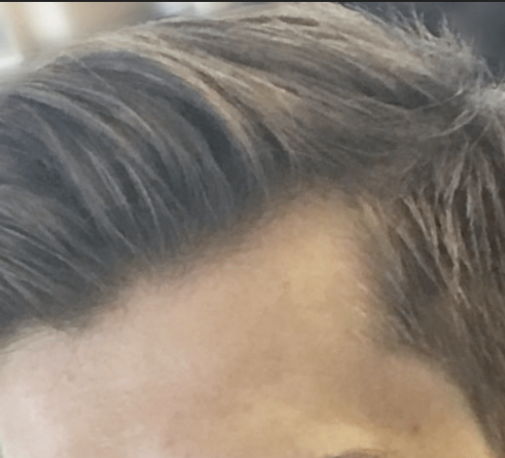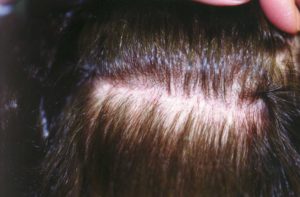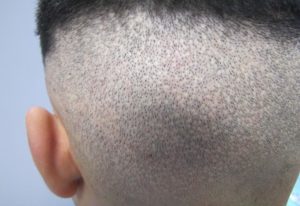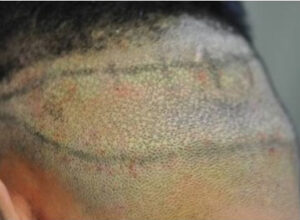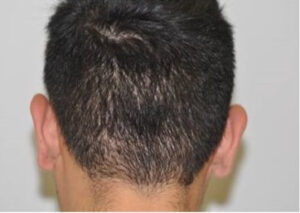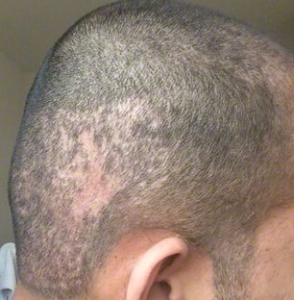FUT & FUE
Strip FUT vs Punch FUE
There are four main mechanical segments to the hair transplant process.
- The extraction of the donor hair for the hair bank (the good genetic hair around the sides and back of the scalp). It can be removed with a punch tool or removed as a strip excision.
- Punch Excision – FUE
- 4 mm punch excisions – how hair transplants first started back in 1959 (the pluggy corn-row look).
- 0.8-1.2 mm punch excisions – the current method
- Strip Excision – FUT
- Punch Excision – FUE
- The dissection/trimming of the donor grafts under the Stereoscopic Microscope
- The making of the recipient incisions
- The planting of the grafts into the recipient incisions
Follicular Unit Excision
Follicular Unit Excision (FUE) is also called MPE (Multiple Punch Excisions). The only difference with FUE over the years is the size of the excision tool used to excise the donor tissue. This tool is used to surgically cut through the tissue of the donor scalp into the subcutaneous tissue in order to remove the hair follicle. This creates a circular scar. The FUE graft does not survive if this is not done.
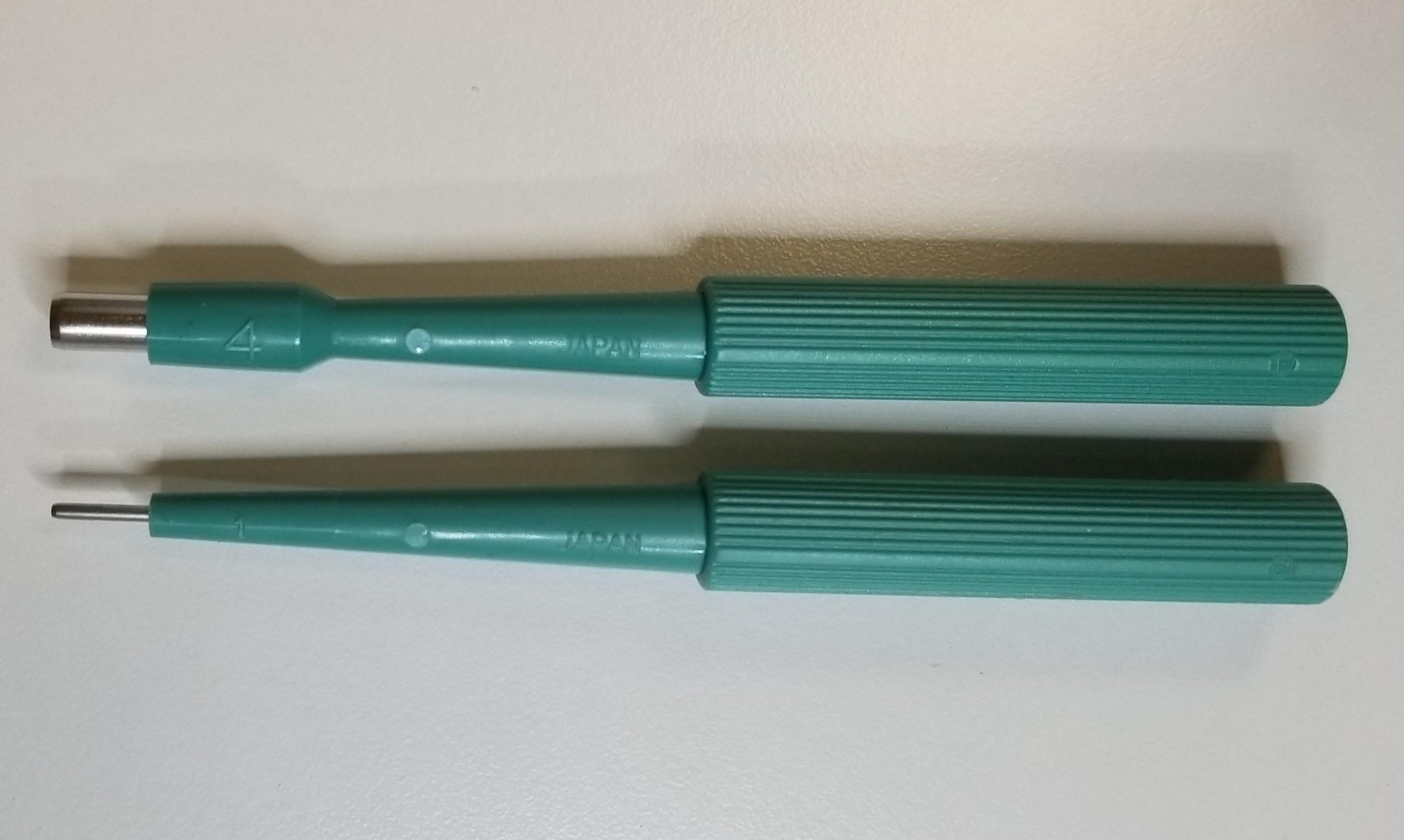
Top- 4mm Punched used in 1959
Bottom- FUE punch that is used today

Left- 4mm Punched used in 1959
Right- FUE punch that is used today
Hair Transplant Process
FIRST STEP
First step of the hair transplant process (how we excise the tissue out of the donor area) is the main difference between strip excision FUT and punch excision FUE hair transplants.
SECOND STEP
Second step (use of Stereoscopic Microscope) is vitally important in both strip FUT and punch FUE hair transplants. Unfortunately, the vast majority of doctors marketing punch FUE hair transplants have never seen or used a Stereoscopic Microscope. One of the major downsides to FUE hair transplants is it takes away one of the key benefits of the stereoscopic microscope. A key importance of the Stereoscopic Microscope is that is gives us 100% visualization of natural hair groupings, so we can see each and every follicular unit while we are dissecting – this equates into less trauma and transection of the follicular unit grafts. With any FUE device (Neograft, Smartgraft, Artas Robot, or other motorized/manual tool) used to surgically punch excise the donor tissue in the FUE hair transplant, the doctor does not know if he transected the follicular units until after the graft is removed, and the damage to the follicular unit is already done. Unfortunately, this increased transection rate of the follicular unit decreases the survival of the very limited donor hair. The Stereoscopic Microscope is vitally important in FUE hair transplants because it enables us to trim excess skin away from the punch excision (excess skin just adds bald scalp). The Stereoscopic Microscope is also valuable to verify the size of the graft removed with the FUE punch to avoid placing bigger grafts on the hairline (avoiding an unnatural look).
THIRD & FOURTH STEPS
Third step (making the incisions) & fourth step (planting the grafts) should be performed the same way by your doctor when performing either FUT or FUE surgical hair transplants.
Both strip FUT and punch FUE techniques have their strengths and weaknesses; therefore, it is critical to understand this and use the appropriate technique depending on the patient and the circumstances.


FUT & FUE
TRUTH vs FALSE
The advent of FUE Hair Transplants has brought about a lot of very unethical marketers, doctors and unlicensed technicians, and companies that have very little knowledge of the pathophysiology of hair loss and even less knowledge of the art of hair transplants. Unfortunately, they are making claims that are outright lies and mistruths. If your doctor is allowing an unlicensed technician to use the FUE device (Neograft, Smartgraft, Artas robot, or other device/scalpel), this is illegal, and you should report the doctor to the state medical board and local authorities.
Claim - "FUE hair transplants are scar-less”
This is false. It’s usually being said by untrained doctors who have purchased an automated punch excision machine trying to add revenue to their practice without using their own time, so they allow an unlicensed technician to perform the surgery for them.
Truth:
FUE creates thousands of circular punch scars, it does not create a linear scar unless the doctor doesn’t know what he is doing.
The punch excision tool used to perform FUE has been used by dermatologist for a century and we know it creates scars for the last century. A 1mm punch excision tool used in FUE creates approximately a 1.2 mm white circular scar. In the 1950’s, hair transplants got its origins in the United States from this 4-5mm punch excision tool.
The surface area of scar tissue left in the donor region with punch FUE excision is approximately 12 times that of strip FUT excision and it increases with each successive surgery since no scar tissue is removed with FUE. The linear scar from strip FUT is removed with any successive surgeries.
Claim - “FUE Hair transplant is non-surgical and incision-less”
This is false, and usually made by unethical doctors marketing FUE hair transplants.
Truth:
Every form of hair transplant is surgical and involves excisions (the cutting of tissue) which creates scars. In fact, FUE hair transplants creates over 12 times the surface area of excised tissue as a FUT hair transplants. There is much more cutting of tissue with the FUE technique.
Claim - “FUE Hair transplants are painless”
This is false. Any form of hair transplants has to have local anesthesia which involves a certain degree of discomfort.
Truth:
Many times, FUE hair transplants involve much larger area of donor area removal in order to spread out the scar tissue; therefore, the discomfort would be greater since a greater area would have to be anesthetized.
Claim - “Strip surgeries create spread scars”
This is false.
Truth:
Strip excision follicular unit (FUT) hair transplants typically create very thin linear scars that even short haircuts hide and are hard to find. The biggest risk of a spread scar is when a doctor takes out too wide of a strip and closes the wound under tension. This is typically caused by doctors performing “mega-sessions” since they typically need to take wide strips to meet the number of grafts. Stopping mega-sessions hair transplants will prevent most patients from getting spread scars. Currently most of the “mega-session” hair transplant doctors perform FUE hair transplants since it is easier to market.
PROS & CONS
Below is a chart of the short-term and long-term pros and cons of a patient with #2,000 graft FUE-punch excision hair transplant versus a #2,000 graft follicular unit hair transplant with a FUT-strip excision.
Short Term
FUE- #2,000 grafts of punch excisions
| SHORT TERM FUE PROS | SHORT TERM FUE CONS |
| No need for sutures | Scalp needs to be shaved completely resulting in having no hair to hide the healing process |
| Takes weeks sometimes months for the hair to regrow to hide the #2,000 healing punch holes | |
| Much more surface area of donor scalp exposed to surgical cutting/excision—i.e.-more trauma to the donor area |
Strip Excision (FUT) removing 2000 grafts
| SHORT TERM FUT PROS | SHORT TERM FUT CONS |
|
No need to shave the scalp, so the donor site and sutures are hidden the day you walk out of surgery |
The donor site needs sutures that are removed in 1 week. |
Long Term
FUE- thousands of punch excisions
| LONG TERM FUE PROS | LONG TERM FUE CONS |
| Patient will not have a linear scar | The patient will have 2,000 1.2mm circular scars which equates into approximately 2,400 mm² of scar tissue to the donor area. Strip excision for 2,000 grafts typically creates a 1mm x 200mm linear scar which equates to 200mm² of scar tissue. Therefore, there is approximately 12 times more scar tissue with punch FUE excision technique |
| In order to spread out this increased amount of scar tissue, many doctors punch excise hair outside of the boundaries of where the good genetic hair is. Therefore, those grafts are only temporary and will eventually miniaturize and go away. | |
| FUE/Punch excision technique exposes each graft to “blind dissection” which means the doctor cannot see through the tissue he is cutting with the punch. Therefore, he does not know if he has transected and destroyed the hair follicle until after it is already done. Transected hair follicles have much poorer survival. | |
| With much more surface area of scar tissue it can lead to the donor area looking “moth eaten”. |
FUT Excision
| LONG TERM PROS | LONG TERM CONS |
| Much less surface area of scar tissue than FUE/Punch excision technique | Will have a linear scar- however this should easily be hidden by even short haircuts and hard to find |
| Can dissect the strip tissue under the stereoscopic microscope to have full visualization while dissecting the hair follicles, as opposed to blind dissection. Full visualization of the hair follicle while dissection gives greater ability to decrease the transection rate of the grafts which increases the survival of the grafts. |
At an increased risk of a spread scar if the surgeon tries to take out too much tissue to do a mega-session. Solution – don’t let your surgeon perform a mega-session hair transplant. You can always do another hair transplant tomorrow, but if you deplete the donor area you won’t have enough in the “hair bank” to do so in the future. |
| Can remove the tissue from the area of the best genetic hair |
In conclusion, both strip FUT and punch FUE hair transplants cause scars in the donor region. If you shave your head completely, the donor scars will be visible – especially the more hair transplants you have had. It is of utmost importance to try to get the best survival of the good genetic hair and to create the least amount of scar in the donor region with any hair transplant.
*Model is an actual patient
Feel at ease with
your own hair.
Welcome to Dr. McAndrews’ Practice in Pasadena. Feel at ease that you are with the expert who trains other doctors on the latest advances in hair transplants. We are at the forefront of hair transplant, corrective hair transplant surgery, and medical hair loss treatment technology. We are dedicated to giving our patients the best hair restoration results with the highest level of service and care.








Our Locations in Los Angeles

Beverly Hills
435 N Roxbury Dr,
Beverly Hills, CA 90210

Pasadena
50 Alessandro Place, Suite 115, Pasadena, CA 91105
The McAndrews Method:
Informed Decision, Artful Precision, Unparalleled Results.
Dr. McAndrews' sole focus on his patients enables him to artistically and precisely create the best natural-looking results.
Get In Touch
If you have any further questions or would like to schedule a consultation, please do not hesitate to call or email us. You may also fill out the form provided to request more information.

